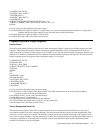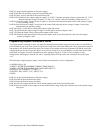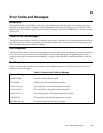
Programming with a Series 200/300 Computer104
LINE 10: Assigns the I/O pathname to the power supply.
LINE 20,30: Enter the operating voltage and current limit point.
LINE 40: Sets C equal to one half of the current limit point.
LINE 50-70: Determines the voltage setting for output 2. It is 20.2 V when the operating voltage is greater than 7 V, 7.07 V
when the operating voltage is between 7 V and 2.5 V, and the same as the operating voltage below 2.5 V.
LINE 80: Clears the supply, sets the current of output 1 to one half of the current limit point, and sets the voltage of output
1 to the operating voltage.
LINE 90: Sets the current of output 2 to one half of the current limit point and sets the voltage of output 2 to the value
determined by the operating voltage.
LINE 100: Waits 1 second before reading back output voltage and current.
LINE 110-160: Reads the output voltage of output 1 and the output current of outputs 1 and 2.
LINE 170: Prints the output voltage of the parallel outputs on the screen.
LINE 180: Prints the total output current of the parallel outputs on the screen. Note that this is the sum of the output
currents of outputs 1 and 2.
Programming Outputs Connected In Series
To program outputs connected in series, you must first determine the maximum voltage and current that you would like to
have available to your load. These values are the desired voltage limit and current limit points. Next, program the current of
both outputs to this desired current limit point. The voltage of each output can then be programmed so that the sum of the
voltages equals the desired voltage limit point. An easy way to do this is to set each output to one half of the desired limit
point. Refer to Chapter 4 for more information on series operation. Figures 4-13 and 4-14 are examples of series
configurations which apply to both the CV and CC operating modes. Note the sense lead connections shown in Figure
4-14.
The following example programs outputs 1 and 2 which are connected in a series configuration.
10 ASSIGN @Ps to 705
20 INPUT "ENTER THE DESIRED CURRENT LIMIT POINT",I
30 INPUT "ENTER TElE DESIRED VOLTAGE LIMIT POINT",V
40 OUTPUT @s;"CLR;ISET1,";I;’’;ISET2,";I
50 OUTPUT @Ps;"VSET1,’’;V/2;";VSET2,";V/2
60 END
LINE 10: Assigns the I/O pathname to the power supply.
LINE 20: Enter the desired current limit point.
LINE 30: Enter the desired voltage limit point.
LINE 40: Clears the supply and sets the current of both outputs to the desired current limit point.
LINE 50: Sets the voltage of each output to one half of the desired voltage limit point so that the sum is the desired voltage
limit point.


















